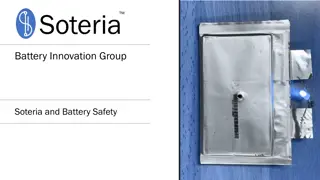Battery Escape Room: Interactive Science Learning Experience
Engage students in a hands-on learning experience with the Battery Escape Room project funded by the EU's Horizon 2020 programme. In this innovative classroom activity, students are challenged to build batteries using everyday materials, explore electrochemistry concepts, and collaborate to solve puzzles. By working in groups, following clues, and applying knowledge, students discover the color coding system to escape the room. The engaging scenario and practical application of science concepts make learning fun and memorable.
Download Presentation

Please find below an Image/Link to download the presentation.
The content on the website is provided AS IS for your information and personal use only. It may not be sold, licensed, or shared on other websites without obtaining consent from the author. Download presentation by click this link. If you encounter any issues during the download, it is possible that the publisher has removed the file from their server.
E N D
Presentation Transcript
Battery Escape Room This project has received funding from the European Union s Horizon 2020 research and innovation programme under grant agreement No 665100.
The lesson starts with an introduction by the teacher: e. g. Today I would like to play a very special game with you. Imagine it s your Birthday and you ve invited all of your classmates to your party in the (party room in the) cellar. You are listening to music, drinking and dancing. Suddenly, you hear the door bang and someone locking the door from outside. The next thing you hear is your brother s voice from the other side of the door. After this introduction, the teacher starts the play back of the audio recording (next slide)
German version as an example Recording of brother Let s get this party started. Because I love you so much, I have an extra present for you and your friends, and prepared your very own escape room: you ve been raving of wanting to become an electro chemist since your industrial placement. You want to develop tomorrow s electric cars? Now you have the chance to show what you can do. For this task, it s extremely important to work as a team and agree with each other. Further, you will need creativity and take delight in tinkering. Having paid attention in chemistry and physics classes, won t do any harm either. In order for me to let you out, I want to know from you, which two groups belong together. You will recognize your group based on the colour of your lamp. It will only flash if you put together the battery properly, before you run out of time. Now if that isn t the perfect challenge for a future electro chemist (diabolical laugh). If you complete the task, I promise that from now on, I will take your career aspirations more serious! Now, go to the batteries and ready, steady, go! All the materials needed, are in the box (end of recording)
Inquiry (Science learning) & Consolidation: Chemistry (Physics): Learning content: Batteries, electrochemistry - Methods: e.g.: The Teacher then writes timing on the black board (you have minutes) and gives start signal. The students are now asked to build batteries using everyday material in small groups (3 to max. 5 students). The material is in boxes on their table. Each group get slightly different materials for their batteries. The Escape Room challenge is solved when each group finds out about their light s colour. It is possible that the groups help each other after finishing their own battery. The students can also use prepared clue cards to solve the problem. Material: 6 small LED lights in 2 or three colours (transparent, approx. 1V) electrolyte media as salt bridge for 6 groups (already cut into suitable size, e.g. cucumbers, apples, ) 5 cent coins galvanized screws control wires in different colours (0,14mm, already uninsulated at their ends) The teacher can also use 3 more audio recordings with clues for the remaining time, that can be used flexible by the teacher You have 15 minutes left! / The last 5 minutes have begun! / The last minute, time s running! When the task has been solved, the teacher can start a dialog with the students: Which materials did you need to build the electric circuit? What do the different parts in each group have in common?























